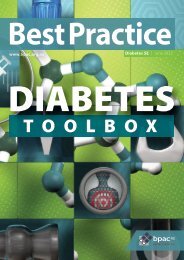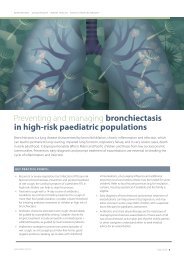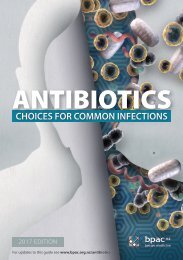Create successful ePaper yourself
Turn your PDF publications into a flip-book with our unique Google optimized e-Paper software.
Interpretation of leukocyte esterase and nitrites on dipstick in females<br />
Urine dipstick testing is not necessary to diagnose a<br />
textbook UTI, but in practice it is often performed as the<br />
presence or absence of leukocyte esterase and nitrites<br />
can provide useful information, e.g. ruling out a UTI in a<br />
patient with non-specific symptoms.<br />
Leukocyte esterase is an enzyme released by<br />
neutrophils and macrophages. A urine dipstick positive<br />
for this enzyme indicates pyuria (an increased number<br />
of leukocytes). UTIs are a common cause of pyuria and<br />
haematuria, but also consider sexually transmitted<br />
infections such as chlamydia. 26 The presence of leukocyte<br />
esterase on dipstick may also be due to non-infectious<br />
renal diseases such as glomerulonephritis. Contamination<br />
of samples by vaginal secretions may cause a false-positive<br />
result.<br />
Nitrites are generally found in urine due to the<br />
reduction of nitrates to nitrites by Gram-negative bacteria<br />
such as Escherichia coli. The detection of bacteria in urine<br />
by nitrite positive dipstick is also dependent on nitrates<br />
from the patient’s diet (vegetables) and incubation time<br />
in the bladder. Gram positive uropathogens such as<br />
Staphylococcus saprophyticus and Enterococcus do not<br />
produce nitrate reductase and the dipstick will be negative<br />
for nitrites if the infection is due to these bacteria.<br />
References<br />
1. Anderson J, Fawcett D, Goldberg L, et al. Joint consensus statement on the<br />
initial assessment of haematuria. Prepared on behalf of the Renal Association<br />
and British Association of Urological Surgeons. 2008; Available from: www.<br />
baus.org.uk/_userfiles/pages/files/News/haematuria_consensus_guidelines_<br />
July_2008.pdf (Accessed Jul, <strong>2020</strong>)<br />
2. Bataille A, Wetzstein M, Hertig A, et al. Evidence of dipstick superiority<br />
over urine microscopy analysis for detection of hematuria. BMC Res Notes<br />
2016;9:435. doi:10.1186/s13104-016-2240-y<br />
3. Jimbo M. Evaluation and management of hematuria. Prim Care 2010;37:461–72.<br />
4. Yeoh M, Lai NK, Anderson D, et al. Macroscopic haematuria - A urological<br />
approach. Aust Fam Physician 2013;42:123–6.<br />
5. Rao PK, Jones JS. How to evaluate ‘dipstick hematuria’: what to do before you<br />
refer. Cleve Clin J Med 2008;75:227–33.<br />
6. National Institute for Health and Care Excellence (NICE). Suspected cancer:<br />
recognition and referral. 2015. Available from: www.nice.org.uk/guidance/<br />
NG12/chapter/1-Recommendations-organised-by-site-of-cancer#urologicalcancers<br />
(Accessed Jul, <strong>2020</strong>)<br />
7. Burger M, Catto JWF, Dalbagni G, et al. Epidemiology and risk factors<br />
of urothelial bladder cancer. Eur Urol 2013;63:234–41. doi:10.1016/j.<br />
eururo.2012.07.033<br />
8. Murtagh J. John Murtagh’s General Practice. 5th ed. Sydney; New York:<br />
McGraw-Hill 2011.<br />
9. National Institute for Health and Clinical Excellence (NICE). Chronic kidney<br />
disease: Early identification and management of chronic kidney disease in<br />
adults in primary and secondary care. 2008.<br />
10. National Health Committee. Haematuria: Presentation, diagnostic pathway and<br />
alternative diagnostic options. 2015.<br />
11. Prostate Cancer Working Group, Ministry of Health. Prostate cancer<br />
management and referral guidance. 2015. Available from: www.health.govt.<br />
nz/publication/prostate-cancer-management-and-referral-guidance (Accessed<br />
July, 2019).<br />
12. Davis, R, Jones S, Barocas D. Diagnosis, evaluation and follow-up of<br />
asymptomatic microhematuria (AMH) in adults: AUA guideline. 2012. Available<br />
from: www.auanet.org<br />
13. Guidelines and Protocols Advisory Committee. Microscopic hematuria<br />
(persistent). 2009. Available from: www.bcguidelines.ca/pdf/hematuria.pdf<br />
14. Trivedi D, Messing EM. Commentary: the role of cytologic analysis of voided<br />
urine in the work-up of asymptomatic microhematuria. BMC Urol 2009;9:13.<br />
doi:10.1186/1471-2490-9-13<br />
15. Kassouf W. Clinician’s corner: The value of urine cytology in the workup of<br />
hematuria. Cancer cytopathology 2016;:303–4.<br />
16. Nakamura K, Kasraeian A, Iczkowski KA, et al. Utility of serial urinary cytology<br />
in the initial evaluation of the patient with microscopic hematuria. BMC Urol<br />
2009;9:12. doi:10.1186/1471-2490-9-12<br />
17. Ministry of Health (MOH). Managing chronic kidney disease in primary care:<br />
national consensus statement. Wellington: Ministry of Health. 2015. Available<br />
from: www.health.govt.nz/publication/managing-chronic-kidney-diseaseprimary-care<br />
(Accessed Jul, 2019)<br />
18. Kyle C (Ed). Sonic pathology handbook: a guide to the interpretation of<br />
pathology tests. New South Wales: Sonic Healthcare 2014. Available from:<br />
www.southernpath.com.au/media/6932/pathology-handbook.pdf (Accessed<br />
Jul, <strong>2020</strong>).<br />
19. Lim D, Lee D-Y, Cho SH, et al. Diagnostic accuracy of urine dipstick for<br />
proteinuria in older outpatients. Kidney Res Clin Pract 2014;33:199–203.<br />
doi:10.1016/j.krcp.2014.10.003<br />
20. Browne OT, Bhandari S. Interpreting and investigating proteinuria. BMJ<br />
2012;344:e2339.<br />
21. National Institute for Health and Clinical Excellence (NICE). Proteinuria:<br />
detection and quantifications in adults using ACR - information for GPs. 2009;<br />
Available from: www.renal.org/pages/media/TsarFiles/Proteinuria_GPs.pdf<br />
22. Kashif W, Siddiqi N, Dincer AP, et al. Proteinuria: how to evaluate an important<br />
finding. Cleve Clin J Med 2003;70:535–7, 541–4, 546–7.<br />
23. Haynes J, Haynes R. Proteinuria. BMJ 2006;332:284. doi:10.1136/<br />
bmj.332.7536.284<br />
24. Kidney Health New Zealand. Chronic kidney disease (CKD) management in<br />
General Practice: summary guide. 2014. Available from: www.kidney.health.<br />
nz/resources/file/ckd_management_in_general_practice._2014_version.pdf<br />
(Accessed Jul, <strong>2020</strong>)<br />
25. Smith D, Yong K. Multiple myeloma. BMJ 2013;346:f3863. doi:10.1136/bmj.<br />
f3863<br />
26. Lin J, Denker B. Azotemia and urinary abnormalities. In: Harrison’s principles of<br />
internal medicine. McGraw-Hill Australia Pty Ltd 2015. 289–95.<br />
27. Simerville JA, Maxted WC, Pahira JJ. Urinalysis: a comprehensive review. Am<br />
Fam Physician 2005;71:1153–62.<br />
52 Best Practice Journal – SCE Issue 1 www.bpac.org.nz









